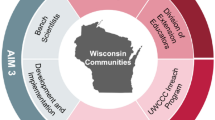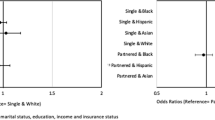Abstract
The National Comprehensive Cancer Control Program has experienced exponential growth over the past 20 years due to the coordination and collaboration of many stakeholders to sustain multisector coalitions, develop and execute data-driven plans, and successfully implement evidenced-based interventions across the United States. These stakeholders have worked tirelessly to address the burden of cancer by employing strategies that promote healthy behaviors to reduce cancer risk, facilitate screening, and address the needs of cancer survivors. The interaction between the comprehensive cancer control program and the coalitions to engage in this work has been coined the 3Ps: the partnership, the CCC plan, and CCC program interventions. This article describes the efforts to evaluate the growth of the comprehensive cancer control movement, especially as it pertains to coalition contribution, plan priority development and implementation, and intervention implementation. It describes successes and lessons learned from an evaluation whose findings can be used to bolster and sustain comprehensive cancer control programs and coalitions across the U.S.
Similar content being viewed by others
References
Given LS, Black B, Lowry G, Huang P, Kerner JF (2005) Collaborating to conquer cancer: a comprehensive approach to cancer control. Cancer Causes Control 16(1):3–14
Rochester PW, Townsend JS, Given L, Krebill H, Balderrama S, Vinson C (2010) Comprehensive cancer control: progress and accomplishments. Cancer Causes Control 21(12):1967–1977
Centers for Disease Control and Prevention (2010) Comprehensive Cancer Control Branch Program evaluation toolkit. Division of Cancer Prevention and Control. National Center of Chronic Disease Prevention and Health Promotion, Centers for Disease Control and Prevention, Atlanta
Rochester P, Chapel T, Black B, Bucher J, Housemann R (2005) The evaluation of comprehensive cancer control efforts: useful techniques and unique requirements. Cancer Causes Control 16(1):69–78
Department of Health and Human Services (2012) DP12-1205: Cancer Prevention and Control Program for state, Territorial and Tribal Organizations. Atlanta
Steele CB, Rose JM, Chovnick G, Townsend JS, Stockmyer CK, Fonseka J, Richardson LC (2015) Use of evidence-based practices and resources among Comprehensive Cancer Control Programs. J Publ Health Manag Pract JPHMP 21(5):441–448. https://doi.org/10.1097/PHH.0000000000000053
Puckett M, Neri A, Underwood JM, Stewart SL (2016) Nutrition and physical activity strategies for cancer prevention in Current National Comprehensive Cancer Control Program plans. J Commun Health 41(5):1013–1020. https://doi.org/10.1007/s10900-016-0184-8
Seeff LC, Major A, Townsend JS, Provost E, Redwood D, Espey D, Dwyer D, Villanueva R, Larsen L, Rowley K, Leonard B (2010) Comprehensive cancer control programs and coalitions: partnering to launch successful colorectal cancer screening initiatives. Cancer Causes Control CCC 21(12):2023–2031. https://doi.org/10.1007/s10552-010-9664-9
Underwood JM, Lakhani N, Finifrock D, Pinkerton B, Johnson KL, Mallory SH, Migliore Santiago P, Stewart SL (2015) Evidence-based cancer survivorship activities for comprehensive cancer control. Am J Prev Med 49(6):S536–S542. https://doi.org/10.1016/j.amepre.2015.08.011
Patton MQ (2008) Utilization-focused evaluation. SAGE, Thousand Oaks
Patton MQ (1997) Utilization-focused evaluation: the new century text, 3rd edn. Sage, Thousand Oaks
Townsend JS, Moore AR, Mulder TN, Boyd M (2015) What does a performance measurement system tell us about the National Comprehensive Cancer Control Program? J Publ Health Manag Pract 21(5):449–458. https://doi.org/10.1097/phh.0000000000000124
Centers for Disease Control and Prevention (2018) Comprehensive cancer control plan search. US Department of Health and Human Services, Atlanta
Stewart SL, Hayes N, Moore AR, Bailey R, Brown P, Wanliss E (2018) Combating cancer through public health practice in the United States: an in-depth look at the National Comprehensive Cancer Control Program. In: Majumder AA (ed) Public health—emerging and reemerging issues. Intech, Rijeka
Bauer UE, Briss PA, Goodman RA, Bowman BA (2014) Prevention of chronic disease in the 21st century: elimination of the leading preventable causes of premature death and disability in the USA. Lancet 384(9937):45–52. https://doi.org/10.1016/S0140-6736(14)60648-6
Frieden TR (2014) Six components necessary for effective public health program implementation. Am J Publ Health 104(1):17–22
Partnership CCCN (2018) About us. https://www.cccnationalpartners.org/about-us. Accessed 18 July 2018
Author information
Authors and Affiliations
Corresponding author
Rights and permissions
About this article
Cite this article
Pyron, T., Fonseka, J., Young, M. et al. Examining comprehensive cancer control partnerships, plans, and program interventions: successes and lessons learned from a utilization-focused evaluation. Cancer Causes Control 29, 1163–1171 (2018). https://doi.org/10.1007/s10552-018-1113-1
Received:
Accepted:
Published:
Issue Date:
DOI: https://doi.org/10.1007/s10552-018-1113-1




